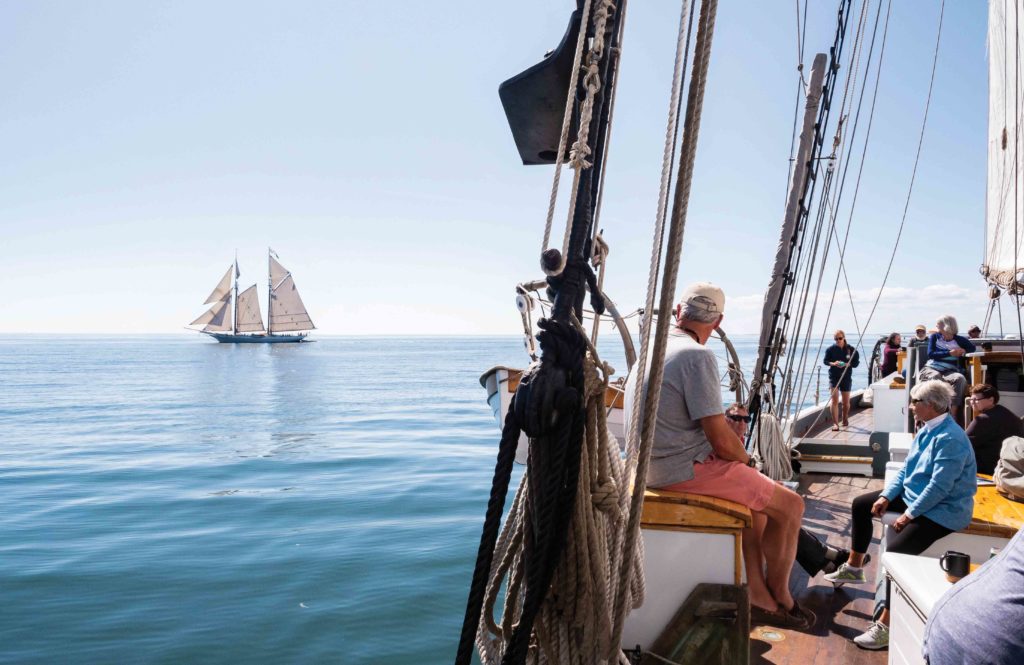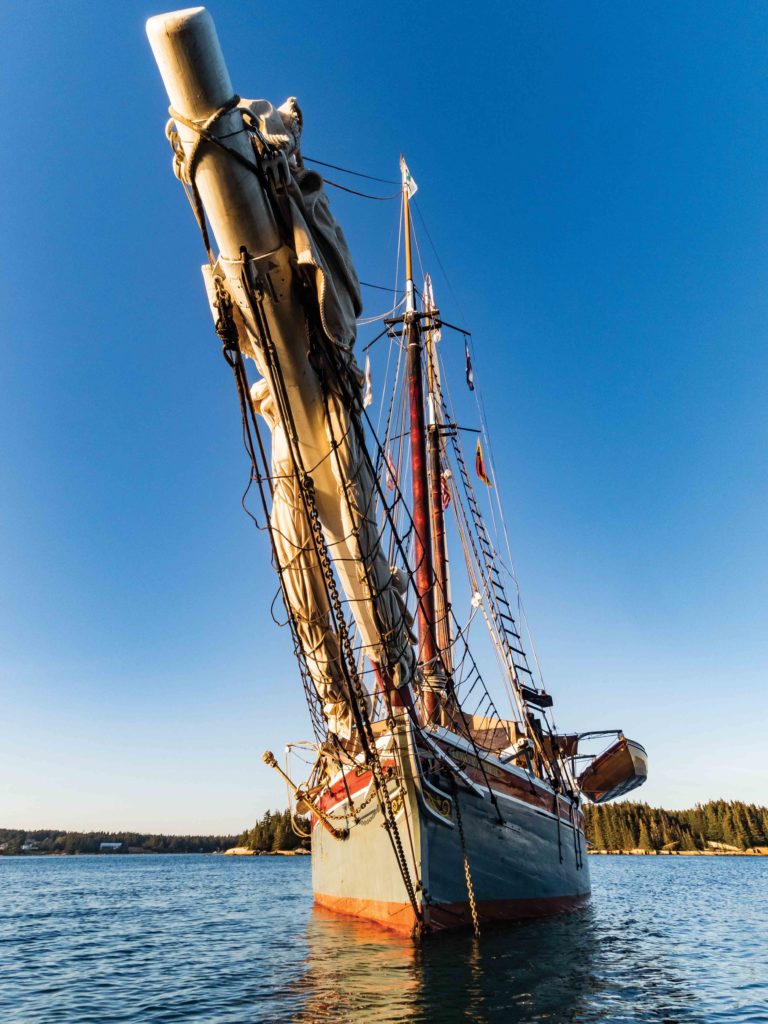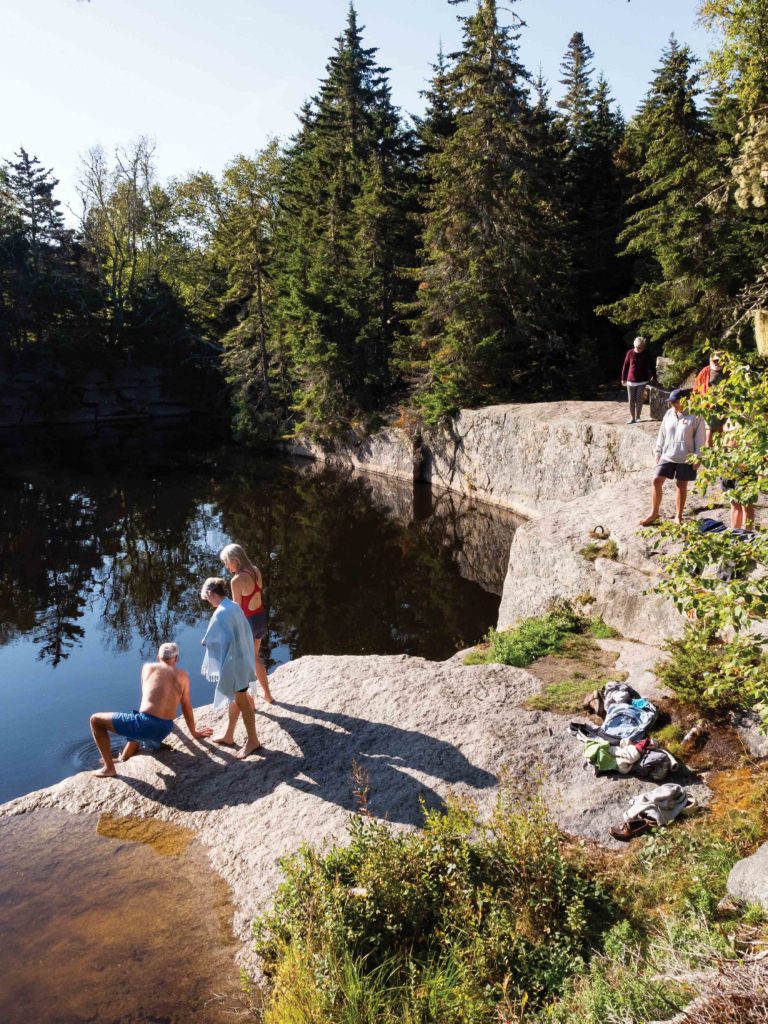French Lessons
Three days on Penobscot Bay, under sail and under stars on Maine’s oldest working vessel, the 1871 schooner Lewis R. French

A monarch butterfly is flitting overhead along the ship’s deck. We’re gliding past the Camden Yacht Club, and the bright-winged traveler stays with us for a while, as if wanting to go to sea, too.
So far, we’ve been moving under the motorized power of a 1980s yawl that’s positioned at the stern of our two-masted schooner to push us from this snug midcoast harbor. The tall ship we’re on has no engine, and soon we’ll be out in Penobscot Bay and sailing on a wooden boat that first launched from a Maine cove almost 150 years ago. As we move farther from shore and into the bay’s salty air and lapping water, it’s already thrilling. The nineteenth-century schooner Lewis R. French is a National Historic Landmark and the smallest of the eight boats in the Maine Windjammer Asso-ciation’s fleet that carry passengers on multiday trips from Camden or Rockland. To me, who’s often in a canoe or a dinghy in summertime, this sailing ship with a 65-foot deck and 19-foot beam feels absolutely grand.
CAMDEN OVERNIGHT
We boarded yesterday, a balmy September afternoon, with the other passengers—there are 19 of us, plus four crew—and unloaded gear below deck. In the evening Camden Harbor was still full of boats of all sizes. We heard the strumming of guitars from boat decks and restaurants, and we hardly needed a sweater.
The crew greeted us as we arrived, guiding each person or pair to assigned cabins in what was originally a cargo hold for everything from herring to granite to Christmas trees. Converted into compact, one- or two-person sleeping spaces, the wood-paneled rooms, accessed from the deck by ship ladders, are no-frills. The cabin I’m sharing with my partner for such adventures, photographer Peter Frank Edwards, is outfitted with two bunk beds, a small sink, and plenty of hooks for jackets and hats. Everything’s arranged around a spot of floor space not much larger than a doormat or two, and there’s no closet. Luckily we each have only a small duffel. Like the schoolteachers, retirees, nurses, and other passengers we’ve just met, we’re ready to trade plugged-in life for the three days of sailing ahead.

Looking up at the 1871-built Lewis R. French from a launch boat. 
The Lewis R. French can carry up to 21 guests and features a 65-foot-long deck and a galley and cabins below. McKenzie Kimball prepares the dinghy for use.

The ship’s white sailcloth was sewn by Nathaniel Wilson Sailmaker of East Boothbay. 
Darcy Cogswell checks the rigging on one of the historic windjammer’s tall masts.
It’s a tried-and-true ritual for guests on the French to spend the first night on board while the ship’s still at the dock in Camden. This, I learn from the crew, gives everyone a chance to begin getting acclimated to the schooner—and the opportunity to walk into town for any forgotten items. For us it’s a chance to return to a favorite restaurant, Long Grain. (I recommend the garlic-chive rice cakes and the shishito peppers with waving bonito flakes on top.)
It was last night, in homeport, when I learned that using the bottom bunk as a step to the top bunk is the only way to climb up. “Be careful or you’ll bump your head” is the crew’s advice. I bump mine anyway, the first time I sit up in bed. But that learning curve is fast. Compact as it is, the cabin has comfortable mattresses made up with sheets, blankets, and pillows, and small windows that open onto the deck for extra ventilation. If the door is open, fresh air and daylight filter in from above. There are no electrical outlets, but there are reading lights above each bunk. There are two marine “heads” with toilets on deck, and a galley below deck toward the bow where the cook and mates will keep the wood-fired oven going for meals and hot drinks. We’re all set.
THE WIND BEGINS
“I can actually see the wind coming,” the captain says once we’re out of the harbor. Garth Wells’s brown hair is partly tucked under a ball cap, and he’s dressed in a flannel shirt and hooded sweatshirt, similar to what the crew wears. He’s got a natural confidence gained from experience, having worked on the French since 1998, first as a mate and then as its captain and owner. Soon Wells cuts the engine on the yawl. All motor sounds end, and he says to the passengers in earshot, “You want to try sailing?”
The crew is ready: three women ably prepare to raise the sails, inviting any interested passengers to line up and heave-ho to help unfurl and hoist the sails by hand. On the oldest surviving Maine-built schooner, even the sails have a regional connection: the white sailcloth was sewn by Nathaniel Wilson Sailmaker of East Boothbay. Most of us join in on the group sail-raising effort—an opportunity that will happen numerous times over the course of the sailing days, along with chances for passengers to team up to push and pull the windlass crank that lifts the anchor, or even to try steering the ship from the helm.

On the three- to six-night excursions, passengers like John Mitchell and Paul Revier can learn from the captain and crew about navigation, sailing, and even try steering the wheel. 
Captain Garth Wells, U.S. Coast Guard–licensed captain and lifelong sailor, was a crew member for years before purchasing the French with his wife, Jenny Wells, in 2004.
Meanwhile, similar to that migrating butterfly, Captain Wells watches the horizon ahead, ever making sense of wind and geography to plot a route. He stays mostly within an arm’s reach of the big captain’s wheel, with maps, chart plotter, and binoculars near, and there’s always a clutch of passengers around him.
“Did you win the Great Schooner Race this year?” someone asks. “If we had,” Captain Wells says, smiling, “you would have already heard about it.”
The French has often bested the others in the fleet on race day, but in 2019, he explains, the win went to the Stephen Taber, captained by Noah Barnes. The two are longtime friends and are both part of a “brine-ska dance band” named the Dolphin Strikers that plays gigs in wintertime. Camaraderie, pranks, and fine sailing are all part of the festivities of the annual race, which began in 1977. Last summer, the French did win the post-race talent show, however. The captain says the victory was due to some talented passengers, including a good guitarist and another person who could solve any Rubik’s Cube. He explains, “It was kind of interpretative but well received.”
When he’s not busy with navigation or working with the crew, Captain Wells answers questions and tells tales of the schooner’s hauling history. Named for Lewis Robbins French of Damariscotta, the ship was built by French’s three sons and launched in Christmas Cove in 1871. The schooner reportedly carried cargo of up to 82 tons, including loads of lime, herring, sand, bricks, lumber, flour, granite, and Christmas trees. A gasoline engine was added in the early 1920s, and after the ship suffered an onboard fire in Belfast Harbor in 1929, it was extensively rebuilt as a sardine carrier that worked between Maine and Nova Scotia. Sold in the 1970s, the then-century-old vessel was restored to remove the engine, install masts and rigging, and be rein-vigorated for sailing again.
That brings us to now, as we pass another schoo-ner under full sail, the Mary Day, and see kingfishers and an immature bald eagle fishing in the Fox Islands Thorofare. We continue threading between North Haven and Vinalhaven as we talk of the boat and its decades of bringing people rather than cargo to coves and crossings of Penobscot Bay. If you are a captain, crew, or even a passenger, you become part of that lineage and maritime heritage.
ISLAND CIRCUIT
We continue like this for three days and nights. There’s plenty of time for conversation and quiet in the sea breezes and sunshine. We don’t see a drop of rain, and we drop anchor near Green Island and go ashore via the yawl to hike trails. Some of us jump in for a swim in a deep former granite quarry. We take turns rowing the Snitch, a 10-foot dinghy built by Captain Wells a few years ago. We read books and fall into impromptu sing-alongs, led by one of the passengers who brought a guitar. We pass close enough to Stonington’s harbor of lobster boats to clearly read the Opera House sign.

There is a shower on the boat, but some of us get our bath by swimming in the cool, deep former granite quarry on Green Island. 
Captain Garth Wells standing to row.
Every day, from before dawn until after dinner, Katharine Keller, who grew up in California and Switzerland and has family in Camden, is in the kitchen keeping the wood fire going and cooking and baking on an iron stove that was manufactured circa 1900 in Bangor—turning out scones and biscuits, chowders and curries, crunchy salads, and blush-colored apple sauce. (She gets a break from the stove the day we venture out for a campfire-fueled lobster bake on a remote island beach.) Mate Darcy Cogswell is on deck working with the sails or anchor, polishing brass fittings, assisting the captain. McKenzie Kimball, who has previously worked as an Outward Bound instructor in Alaska, is the ever-busy deckhand on the French who also assists with food prep in the galley, helping to bring out dinner plates, hot coffee, and chocolate cakes from below.
AFLOAT IN THE BAY
The celestial views are breathtaking each evening that we’re anchored in the captain’s choice of sheltered coves among the islands. Stars blink from horizon to horizon. There’s time and space to see what’s around us. This stay on the French is my second multinight trip aboard a schooner, and both have been remarkable for the beautiful darkness across the water and the starlit skies, the sense of floating in time suspended. Being unreachable by phone and unable to return to work and cars and worry back on shore isn’t limiting. It’s freeing.

Passengers are shuttled on smaller boats from the schooner to the sandy shore for a lobster bake on an island beach. 
After cooking over a wood fire, the lobsters are poured onto a bed of seaweed.
A particular delight is having the time to read. In the ship’s library, which has several shelves of books to borrow, I choose one to sink into while sitting on deck. It’s A Sailor’s Life, published in 1955. Captain Wells, noticing the blue cover, says it’s one of his personal favorites and that the author, Dutch playwright and seaman Jan de Hartog, gets to the humor and truths of life aboard a boat—notably in chapters titled “Hygiene,” “Crew,” and “Passengers.” Several of us end up reading passages out loud, laughing into the afternoon. And we find the author also has a poetic sensibility.
“My only hope is that, when all is said,” de Hartog wrote, “the image may linger of a late summer’s view of the sea, a ship, the men who sail her, and the gulls that circle over her wake.”
So true, I think. And the memory of circling butterflies, too.
SCHOONER SUMMERS
Visit Maine’s coast from May to October and you’ll likely see tall-masted schooners at docks and moorings and sailing across the bay. Here are some opportunities for a closer look, or to get on board this year:
The Lewis R. French is the oldest tall ship in the Maine Windjammer Association, a fleet of eight masted ships built from 1871 to 1983. The vessels offer over-night sailing trips from either Camden or Rockland.
sailmainecoast.com
On June 21–29 harbors and coves fill with boats for the 58th Annual Windjammer Days and Tall Ships Festival in Boothbay Harbor.
boothbayharborwindjammerdays.org
Watch from onshore or ride along at the annual Great Schooner Race, billed as “North America’s largest annual gathering of tall ships,” on July 3, with boats racing from Islesboro to Rockland.
greatschoonerrace.com
From late spring to early fall, schooners throughout the Maine coast offer charters and two-hour, sunset, and half-day sailing trips. Homeport harbors include Portland, Kennebunkport, Camden, Rockland, Belfast, Rockport, Boothbay Harbor, Bar Harbor, and Castine.

